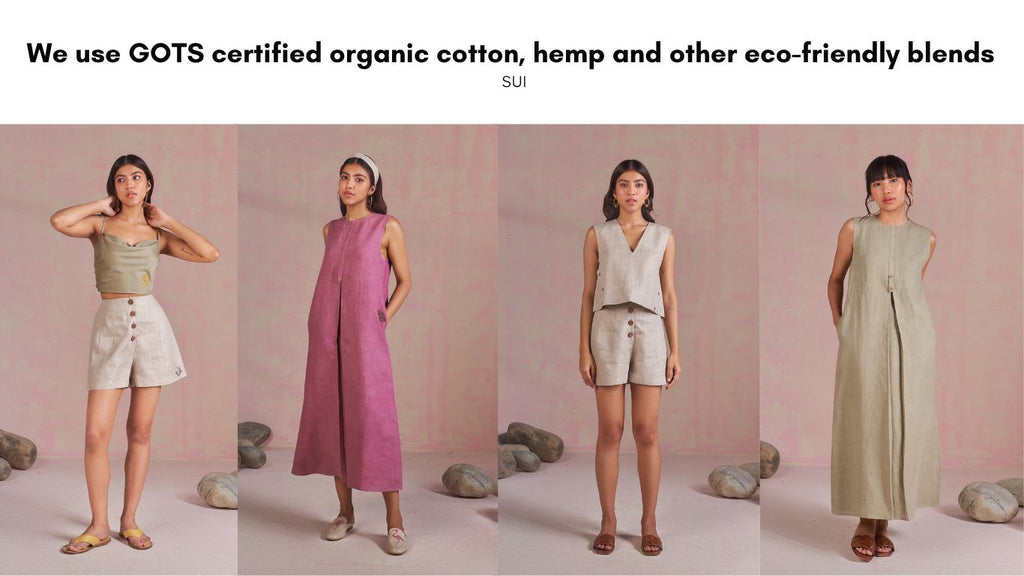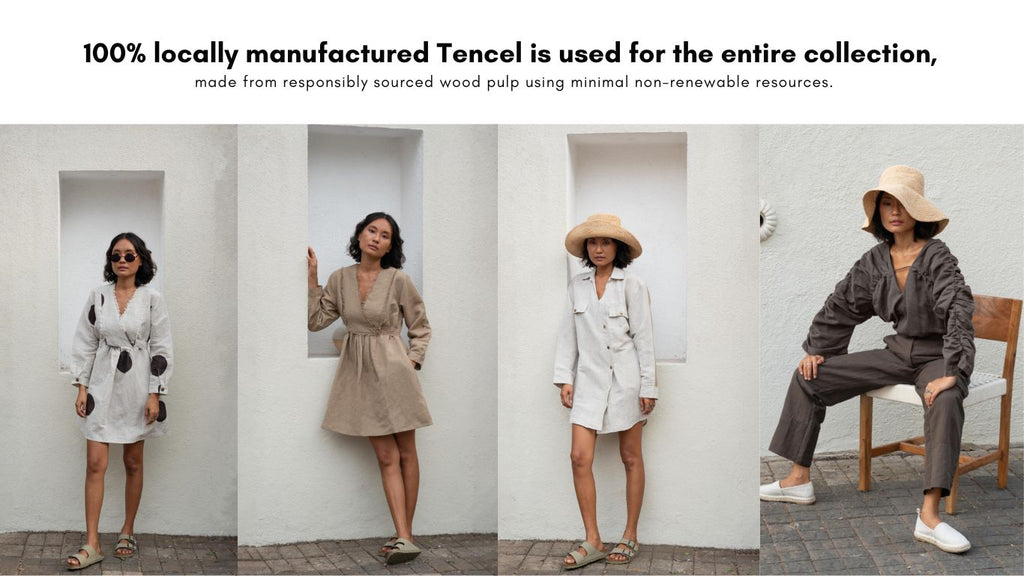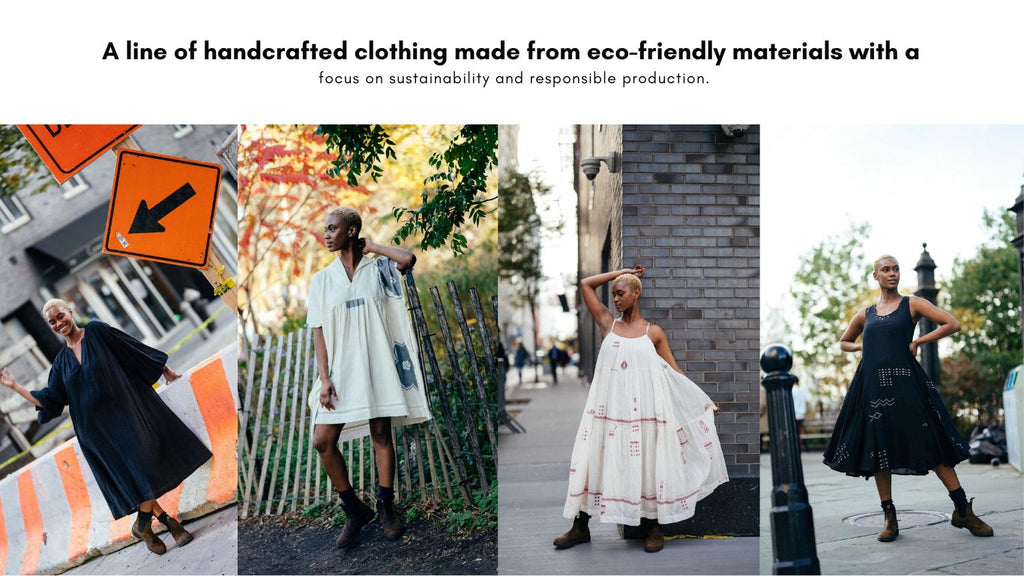“There is no beauty in the finest cloth if it makes hunger and unhappiness.” - Gandhi
Wise words from a great man, famous for dressing simply in a dhoti and shawl. Gandhi's clothing choices made a statement about what he believed it. These days, his words resonate with fashion brands and conscious consumers more than ever before. It's easy to believe, "Oh, I'm just one person - what difference can I make?" But the collective power we consumers possess to make an impact is tremendous. As the ocean is made up of infinite tiny drops of water, so does every conscious purchase decision you make, every sustainable lifestyle option you choose, come together with every other like-minded soul's to create true change.
Of course, if you're here at Canvas & Weaves, you probably already know that. The greater question is, do you actually know what makes a product sustainable? You do your best to buy from a conscious label and shop for sustainable fabric, but have you ever wondered: which is the most sustainable fabric? Which fabric is the best for the planet and the environment? what makes a fabric 'sustainable' or 'ethically sourced'? There are so many choices out there these days: Organic Cotton, Eri silk, Khadi, Tencel, Modal, and more. Eco friendly fabrics for ecofriendly fashion - but if we had to rate the most sustainable, eco-friendly fabric, which would they be? Which is Canvas & Weaves' most popular sustainable fabric choice? Just as important: what is the least sustainable fabric - one which you should avoid? Let’s find out! We rate the most sustainable, eco friendly fabrics in our guide to the top most sustainable fabrics.
MOST POPULAR NATURAL FABRICS
What is the most natural fabric? This is a challenging question, because most 'natural' fabrics these days are blended with synthetics to make the product last longer, and to make it cheaper to manufacture. Here are Canvas & Weaves' top picks for truly natural fabrics, made from sustainable sources.
Organic Cotton: We can't talk about textiles without talking about cotton - but not all cotton fabrics are the same. To be sure you're getting an eco-friendly choice, shop organic cotton! Is organic cotton good for the planet? Well, yes! Organic cotton is grown naturally without the use of synthetic agricultural agents like fertilizers, pesticides, or transgenic technologies. It produces healthy soils that act like sponges, soaking up water during floods and retaining it longer during droughts. But even organic cotton isn't all the same. What is the difference between organic and sustainable cotton? Organic cotton refers to cotton produced by certified organic standards only, with strict requirements such as the use of non-GMO seeds, and without the use of synthetic pesticides and fertilizers. Sustainable cotton goes further, covering additional issues of cultivation and farming practices which impact the environment and population, such as emissions, biodiversity and employee working conditions. Sustainable cotton is inclusive of organically produced cotton due to the beneficial requirements in organic cultivation practices.
CHOLA, ENSO, ONE LESS, THE SUMMER HOUSE and many more brands use sustainable organic cotton in their chic selections. Always a popular choice in warmer climates!
HEMP: Is hemp sustainable fabric? It certainly is! Compared to other crops like cotton, hemp is quickgrowing, doesn’t exhaust the soil, and doesn’t require pesticides. Its durability also means your clothes stay in good shape for a long time. Many conscious buyers find themselves choosing between hemp vs cotton. Hemp as a crop is arguably higher on the eco-friendly scale, but there is no reason to dismiss cotton as a choice either, as long as you do your due diligence. Ultimately, if you enjoy wearing your outfit, and get many years of joy from it, you have chosen well! Terra Tribe and Sui use hemp in their beautiful, tropic-friendly designs. Hemp is comfortable, lightweight, and kind to the skin, and is a very eco-friendly choice.

Bamboo: Bamboo has to be the ultimate multipurpose grass. It features in many Asian cuisines, particularly China and Japan; strong and supple, it has been used for generations to build houses, bridges, homeware... and yes, clothes! Bamboo is a fast-growing, regenerative crop that doesn’t require fertilization. Bamboo fabric is incredibly absorbent, comfortable, and moisture-wicking, a great option if you are active and always on the move. You'll find comfy and fashionable options such as the Blue ocean scrappy Jumpsuit from Rias, the handwoven bamboo shirt from Akaaro or the bamboo socks from One Less.

Linen: Conscious shopping doesn't end with your wardrobe - you can beautify your home with sustainable choices too! Brands such as
Saphed Home use linen in their gorgeous soft furnishings, to add a touch of flair to your living space. Linen is one of the world's oldest-known textiles. Made from flax, linen can be grown without fertilizer and planted in areas where most other crops cannot thrive. Flax can also be used in its entirety (seeds, oil, and crop), meaning there’s no waste. This natural material is also biodegradable—as long as harsh chemicals are left out of the process.
Explore beautiful linen options here
(Link website)
SUSTAINABLE SYNTHETICS
You might associate the word 'synthetic' with those horrible polyester suits from the 80s, but engineered textiles have come a long way - and they're even good for the planet! Here are Canvas & Weaves' two top picks for sustainable manmade fabrics.
ECONYL: What's the best was to recycle waste plastic? Turn it into swimwear with Econyl! What is ECONYL? Econyl is a modern nylon fabric that is made from repurposed elements of industrial plastic, waste fabrics, and fishing nets. This means that when you purchase The Summer House's beachready swimsuits, you help close the loop, conserving water and reducing waste. Shop Now

Tencel/Lyocell: You love Three’s classic silhouettes, The Summer House’s breezy dresses and Sui’s contemporary designs - and who wouldn't! But beyond their beauty and functionality, these brands make Tencel their fabric of choice. Tencel is a type of rayon derived from cellulose fibers that come from tree pulp. Unlike rayon viscose, Tencel goes through a closed-loop process where chemicals are reused and less dangerous to humans. Tencel is famous for being cool, breathable, and silk-like to the touch - perfect for hot and humid weather. This excellent balance between a modern, manufactured fabric and sustainable practices is good for the planet, and for your wardrobe too. Buy Tencel if you want an eco-friendly option that's both comfortable and practical. Discover your favourite Tencel picks at Summer House and Three! (Link website) 
TRADITIONAL FABRICS
Once upon a time, all textiles were sustainable, because they were all handmade and handwoven. Canvas & Weaves celebrates the art of traditional textiles, still in use today.
Khadi was once a textile that represented India's struggle for freedom. Under the leadership of Mahatma Gandhi, khadi-making became a symbol of revolution and resistance. These days, it's so much more. Modern brands have taken this symbolic textile and re-introduced it into our wardrobes with fresh designs and contemporary wearability. Khadi is now the fabric of choice for brands such as Rias, Nirjara and Plavate. But what is Khadi? Khadi is a textile fabric made in India by hand-spun and hand-woven cotton, silk, wool or a mixture of these fibres. Made tradtionally, khadi-weaving uses no modern machines or fuel, being entirely created with hand-operated spinning wheels and looms. Thus khadi-manufacture has a comparatively low carbon footprint. The production of a metre of khadi fabric consumes three litres of water, while one metre of mill-produced fabric requires 55 litres.
Jamdani is a fine muslin textile from Bangladesh. Jamdani is typically woven using a mixture of cotton and gold thread. Jamdani is handwoven and made of 100% natural material. Lightweight and breezy, jamdani is hypoallergenic and is features in the soft, light blouses and dresses. You'll find beautiful options in these traditional fabrics from
Crow and
Tree.
WHAT'S THE LEAST SUSTAINABLE FABRIC?
Now we come to the most important question - what's the fabric you want to avoid, as the most planet-unfriendly option? Truth be told, the least sustainable fabric is the one you throw away. That's right. It doesn't matter what you choose, how carefully you've made your purchase; conversely, it doesn't matter if your child wanted a plastic vinyl cap full of metallic sparkles that will take 200 years to degrade. If you discard your items before they have reached the end of their natural lifespan, they have been wasted, and they have therefore added to the burden of the world's unnecessary waste. But if you use your items to the end of their natural lifespan - yes, even that plastic cap can be handed on, given away, donated, for the next 200 years! - you have made full use of your purchase, and nothing has been wasted.
SO WHAT'S THE BEST CHOICE?
We hope you've enjoyed taking a journey through textiles, and have a better understanding of the efforts made by conscious brands to make it easier for you (and your wardrobe!) to make better, sustainable choices. But now you're wondering: so what is it? What's the best choice? Is it linen? bamboo? tencel? Again, the truth is, as long as what you choose fits your lifestyle, that is the best choice for you. Because if you choose clothes in a fabric you love to wear, you will make full use of it. Are you active, always outdoors, a real sun-worshipper? Pick Tencel, to keep you cool and comfortable, and take on lots of washes! Do you like your clothes simple and easy to care for, minimal fuss? Hemp will keep its shape no matter what you put it through. Do you value tradition and love your clothes to tell a story? A traditional fabric is something you'll treasure. So take it from us - the best choice is your choice, as long as you choose wisely. And hey - you'll look fantastic too!










Leave a comment